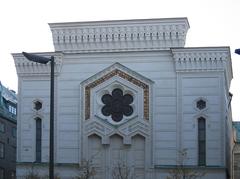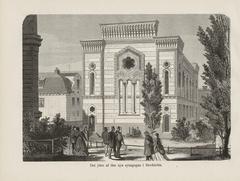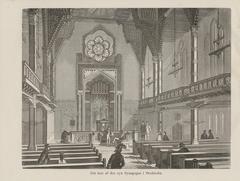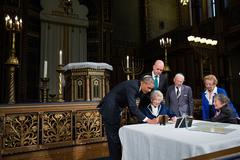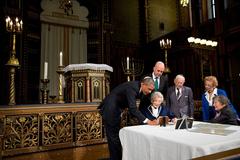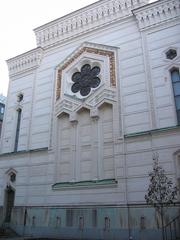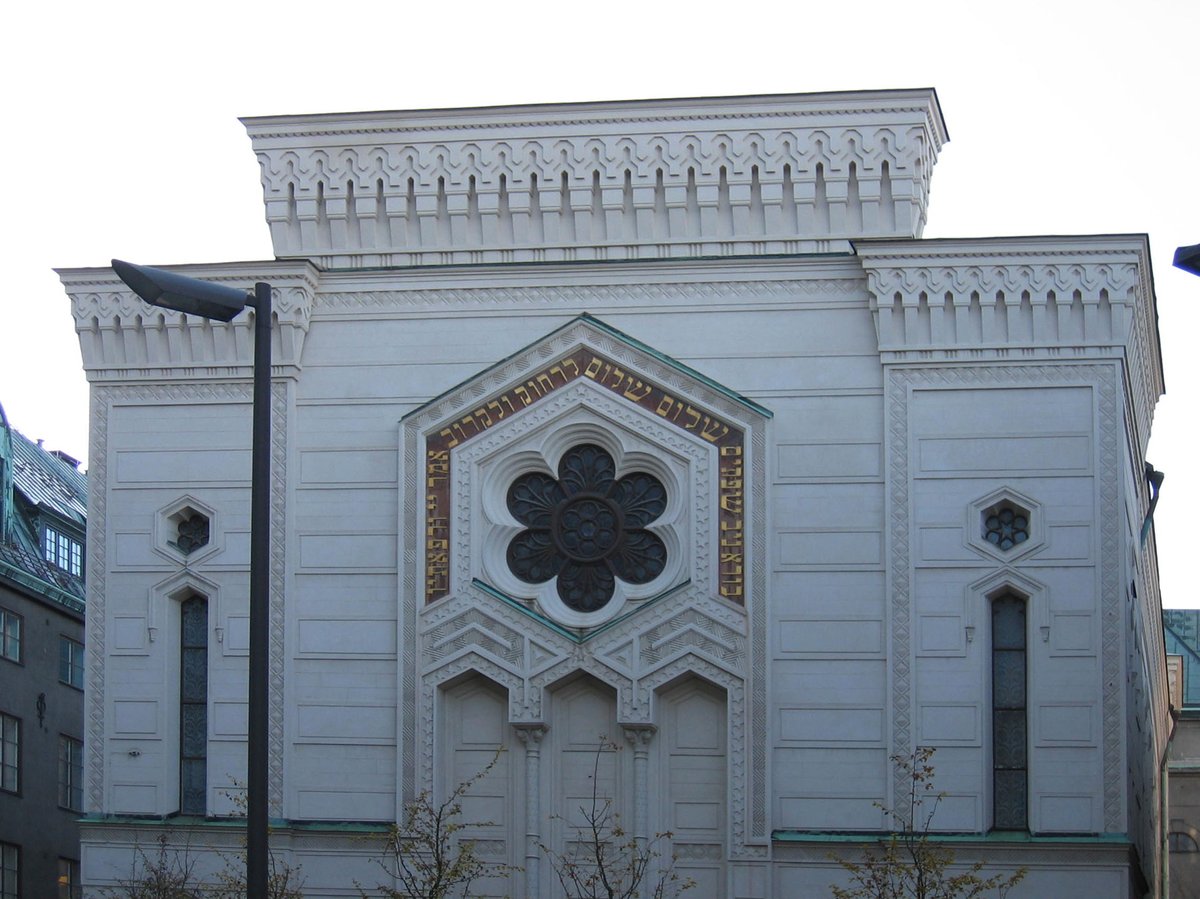
Stockholm Synagogue Visiting Hours, Tickets, and Historical Significance Guide
Date: 14/06/2025
Introduction
The Great Synagogue of Stockholm (Stockholms stora synagoga) stands as a landmark of Jewish heritage and cultural integration in Sweden’s capital. Established in 1870 during a pivotal period of Jewish emancipation, it serves both as an active place of worship and as a cultural beacon reflecting centuries of Jewish presence, resilience, and contribution to Swedish society (Jewish Community of Stockholm; Masorti Olami).
This guide provides detailed insights into the synagogue’s history, architectural significance, and practical information for visitors, including opening hours, ticketing, guided tours, accessibility, and visitor etiquette. Whether you are an architecture enthusiast, a student of history, or a cultural traveler, this resource will help you plan an enriching and respectful visit to one of Stockholm’s most important historical and religious sites.
Table of Contents
- History of the Great Synagogue
- Architectural Features and Style
- Historical and Cultural Context
- The Holocaust Monument
- Contemporary Jewish Life and Community
- Integration with Stockholm’s Urban Landscape
- Visiting the Synagogue: Hours, Tickets, and Tours
- Visitor Etiquette and Accessibility
- Nearby Jewish Heritage Sites
- Visual Highlights
- Frequently Asked Questions (FAQ)
- Practical Visitor Tips
- Booking and Contact Details
- Conclusion and Call to Action
- References
History of the Great Synagogue
Early Jewish Presence and Emancipation
Jewish settlement in Sweden began in the late 18th century, following royal decrees that permitted Jews to settle in select cities. Stockholm became the central hub, with the first congregation founded in 1775. The journey towards full emancipation culminated in 1870, the same year the Great Synagogue was inaugurated, marking a new era of integration and recognition for Sweden’s Jewish community (Jewish Virtual Library).
Conception and Construction
The synagogue was constructed during the 1860s to accommodate the growing Jewish population and their aspirations for visibility within Swedish society. Designed by architect Fredrik Wilhelm Scholander, it blends various architectural styles, symbolizing both the preservation of Jewish tradition and integration with Swedish culture (Wikipedia).
Architectural Features and Style
The Great Synagogue is renowned for its fusion of Renaissance, Baroque, Neoclassical, and Moorish Revival styles. Its symmetrical façade is adorned with horseshoe arches and intricate brickwork in yellow and red, highlighted by stone details. The sanctuary seats nearly 1,000 people, featuring a high vaulted ceiling, large arched windows, and a richly decorated central bimah facing the ornate ark (Aron Kodesh) where Torah scrolls are housed (Masorti Olami; GPSmyCity).
Decorative motifs within include geometric patterns and stylized foliage inspired by Middle Eastern and North African synagogue designs. The synagogue also houses a community mikveh (ritual bath), shared by all three Jewish congregations in Stockholm, underscoring its role as both a religious and communal center.
Historical and Cultural Context
The completion of the synagogue in 1870 coincided with Jewish emancipation, reflecting the community’s growing acceptance in Swedish society. Its central location at Wahrendorffsgatan 3B signifies the prominence and integration of Jewish life in Stockholm (GPSmyCity).
The Great Synagogue is the flagship institution for Swedish Jewry, hosting religious services, life-cycle events, educational programs, and community gatherings. It is affiliated with the Masorti (Conservative) movement, practicing egalitarianism by including women in the prayer quorum and Torah readings.
The Holocaust Monument
A solemn highlight of the synagogue complex is the Holocaust Monument, inaugurated in 1998 by King Carl XVI Gustav. This 42-meter-long engraved wall lists the names of over 8,500 Holocaust victims related to Swedish Jewry, serving as a site for remembrance and education (Masorti Olami). The monument is a focal point for annual commemorations and anti-antisemitism initiatives.
Contemporary Jewish Life and Community
Today, the Great Synagogue remains the center of Jewish religious and cultural life in Stockholm. The Jewish Community of Stockholm encompasses about 4,300 members, with a broader Jewish population of 18,000–20,000 in Sweden. Services are conducted primarily in Hebrew, with elements in Swedish, reflecting the community’s integration.
The synagogue offers regular Shabbat and holiday services, life-cycle celebrations, educational activities for all ages, youth groups, cultural events, and interfaith dialogues. It is led by a resident rabbi and cantor, and runs bi-weekly children’s services, demonstrating its vitality and adaptability (Masorti Olami).
Integration with Stockholm’s Urban Landscape
Centrally situated in Norrmalm, the synagogue is part of Stockholm’s historical and cultural circuit, close to the Royal Palace, Gamla Stan (Old Town), and Kungsträdgården park. It is included in many city walking tours and recognized as a national historical building (Wikipedia; GPSmyCity).
Visiting the Synagogue: Hours, Tickets, and Tours
Visiting Hours
- Guided Tours: Available mainly during summer months (June–August), typically Tuesday through Saturday, 10:00 AM–4:00 PM.
- Religious Services: Shabbat services are held on Friday evenings and Saturday mornings, with additional services on Thursdays.
- Closures: The synagogue is closed to visitors on Saturdays (Shabbat), major Jewish holidays, and occasionally for security reasons. Always verify hours on the official website before visiting.
Tickets and Guided Tours
- Tickets: Admission is free for congregation members. Non-members can purchase tickets at the entrance or online via the official website. Group and special event tickets are available.
- Guided Tours: In-depth guided tours are available and must be booked in advance. Tours are conducted in English and Swedish, with other languages available upon request (Jewish Stockholm Guided Tours).
- Booking Contact: Email [email protected] or call +46 8 587 858 00 for current pricing and bookings.
Accessibility
- Location: Wahrendorffsgatan 3A/3B, Norrmalm, Stockholm.
- Transport: Easily accessible by metro (Kungsträdgården station), bus, and a short walk from Stockholm Central Station.
- Wheelchair Access: The building is equipped with ramps and elevators. Notify staff in advance if special assistance is required.
- Parking: Limited; use public transport or nearby parking garages.
Visitor Etiquette and Accessibility
Dress Code and Conduct
- Modest Attire: Shoulders and knees must be covered. Men may be asked to wear a kippah, provided at the entrance (PaulMarina Synagogue Etiquette).
- Behavior: Maintain respectful silence during services. Mobile phones should be silenced.
- Photography: Allowed in most areas, but restricted during services and in sensitive zones—always ask for permission.
- Security: Expect ID checks and bag inspections due to heightened security at European Jewish sites. Large bags and potential weapons are prohibited.
Nearby Jewish Heritage Sites
- Jewish Museum (Judiska Museet): Located in Gamla Stan, presenting the history of Jewish life in Sweden (Jewish Museum; City Guide Stockholm).
- Adat Jisrael Synagogue: Orthodox congregation in Södermalm, visits by prior arrangement (Adat Jisrael).
- Historic Cemeteries: Aronsberg Cemetery (est. 1776) and the Northern Jewish Cemetery in Solna (jguideeurope.org).
Visual Highlights
- Exterior: Horseshoe arches and decorative brickwork.
- Interior: Vaulted ceilings, ornate central bimah, and detailed motifs.
- Holocaust Monument: Engraved wall with victims’ names.
Explore online galleries and virtual tours on the official website for a preview.
Frequently Asked Questions (FAQ)
Q: What are the visiting hours?
A: Guided tours are available Tuesday–Saturday, 10:00 AM–4:00 PM in summer; services on Fridays and Saturdays. Always verify online before visiting.
Q: How much do tickets cost?
A: Free for members; non-members pay a modest fee, with discounts for students and children.
Q: Can I attend services?
A: Yes, with prior arrangement and adherence to visitor protocols.
Q: Is the synagogue accessible?
A: Yes, with ramps and elevators. Notify staff in advance for assistance.
Q: Are guided tours available in English?
A: Yes, and in Swedish. Check for other language availability.
Q: Is photography allowed?
A: Only in non-service times and with permission.
Practical Visitor Tips
- Check Hours: Visit the official website or contact staff before arrival.
- Dress Appropriately: Modest attire is expected.
- Arrive Early: Especially during peak months or for group tours.
- Travel Light: Due to security and no cloakroom.
- Respect Customs: Follow staff guidance and signage.
- Combine Visits: Pair your synagogue visit with the Jewish Museum and Gamla Stan for a comprehensive experience (Visit Stockholm).
Booking and Contact Details
- Address: Wahrendorffsgatan 3A/3B, 111 47 Stockholm
- Phone: +46 8 587 858 00
- Email: [email protected]
- Official website
Conclusion and Call to Action
The Great Synagogue of Stockholm is not only an architectural masterpiece but also a living center of Jewish faith, culture, and community life. By respecting visitor guidelines and embracing its history, you will gain a deeper appreciation for Stockholm’s multicultural tapestry.
For up-to-date visiting hours, guided tour options, and event calendars, visit the official synagogue website. Enhance your visit with the Audiala app, which offers curated audio tours and real-time updates. Follow our social media for news and insights on Stockholm’s Jewish heritage.
Plan your visit today to experience the enduring significance and welcoming spirit of the Great Synagogue of Stockholm.
